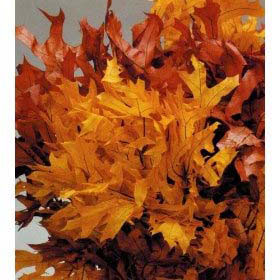The other day, Martha Stewart and I were chatting in the Master Gardener’s office when we were interrupted by a telephone call from a lady asking how to preserve fall leaves. Weren’t we lucky to have the queen of crafts, food and entertaining, weddings, pets, home and garden, and the latest in prison fashion? Here is what the queen bee teaches.
Glycerin Preservation:
 By preserving autumn leaves with glycerin, you can create a wreath that will last for months without drying out. The method will also work with green spring and summer leaves. Some leaves don’t take well to the glycerin method, so experiment. For best results, always cut the branches in the cool of the evening and never use leaves that have been through a frost.
By preserving autumn leaves with glycerin, you can create a wreath that will last for months without drying out. The method will also work with green spring and summer leaves. Some leaves don’t take well to the glycerin method, so experiment. For best results, always cut the branches in the cool of the evening and never use leaves that have been through a frost.
Tools and Materials:
- Pruning clippers or handsaw
- Hammer
- Deep bucket
- pH testing kit (lemons and powdered lime required)
- Glycerin (available at drugstores, craft stores, and some hardware stores)
- Surfactant, such as Spreader Sticker (found in garden centers)
- Florist’s wire; wreath form
Preservation Method:
Select a dozen or so small but leaf-heavy branches from trees at their peak of color. For best results, cut branches at night. Use ones that have not weathered a frost this season; the process will not work on leaves that have seen a frost. Keep in mind that glycerin will change the leaves’ colors. Yellows respond best, becoming more intense; reds and oranges turn a ruddy brown; green magnolia leaves take on a chestnut color but retain their glossy veneer.
- Cut branches from trees with pruning clippers or a handsaw. Pound the end of each branch with a hammer to expose is vascular system.
- Fill a deep bucket with a half-gallon of boiling water (Glycerin, an oil, will dissolve in boiling water only). Test the water pH with a testing kit to make sure it has a pH between 3 and 4. (If pH is too high, add citric acid – lemon juice. If too low, add powdered lime.)
- Add 17 ounces (2 cups plus 2 tablespoons) of glycerin and 4 to 5 drops of surfactant to the water. (The surfactant breaks down the glycerin molecules into smaller ones, enabling the branches to absorb glycerin more easily.)
- Stand the branches in the bucket; place them out of sunlight while the branches and leaves draw up glycerin. After 3 to 5 days, leaves will feel supple. Magnolia branches may take 3 to 6 weeks to absorb glycerin.
- Pick leaves from branches and with florist’s wire bind into small bunches. Position a bunch on a wreath form and bind with wire to hold in place. Wire a second bunch so that leaves overlap wired stems. Continue until circle is complete.
Did I mess that up! So sorry! I mistook Kathy Parent for the queen bee, Martha Stewart.
Alternate Glycerin Method:
The glycerin and water method is generally used to preserve coarser leaves, such as magnolia, rhododendron, beech, holly, heather, or Japanese maple.
Pour the glycerin and water solution (one part glycerin and two parts water) into a flat pan. You will only need about a cup or enough to cover the leaves. Place the leaves in the pan and put a weight on the leaves to keep them submerged (place the leaves between two paper plates and submerge both; place weight on paper plates). Keep the leaves submerged in the solution for 2-6 days. Dry the leaves gently with a paper towel. They should feel soft and pliable.
Wax Paper Pressing Method:
Take the leaves and place them between two paper towels. Dry one side of the leaves by ironing them for 10 minutes on medium heat without steam (move iron continuously). Then turn the leaves over and using a fresh paper towel, repeat process for about 5 minutes.
 Take the dried leaves and place them between two sheets of waxed paper, waxy side against the leaves. Add another sheet of waxed paper to protect the iron and press them again for a minute or so, until the leaves are coated with wax.
Take the dried leaves and place them between two sheets of waxed paper, waxy side against the leaves. Add another sheet of waxed paper to protect the iron and press them again for a minute or so, until the leaves are coated with wax.
Peel off the waxed paper and see how well the leaves have become preserved.
Microwave:
Arrange the leaves on top of two paper towels. Lay another towel over the leaves to cover them. Microwave the leaves
for 30 to 180 seconds. Be very attentive and careful. Leaves that are cooked in the microwave too long can catch fire.
The drier the leaves, the less time they will need. Leaves that curl after removal from the microwave have not been in
long enough. Leaves that are scorched have been in there too long. Only dry them for a few seconds at a time. Let the
leaves sit for a day or two and then finish by spraying an acrylic sealant on both sides of the leaves.
